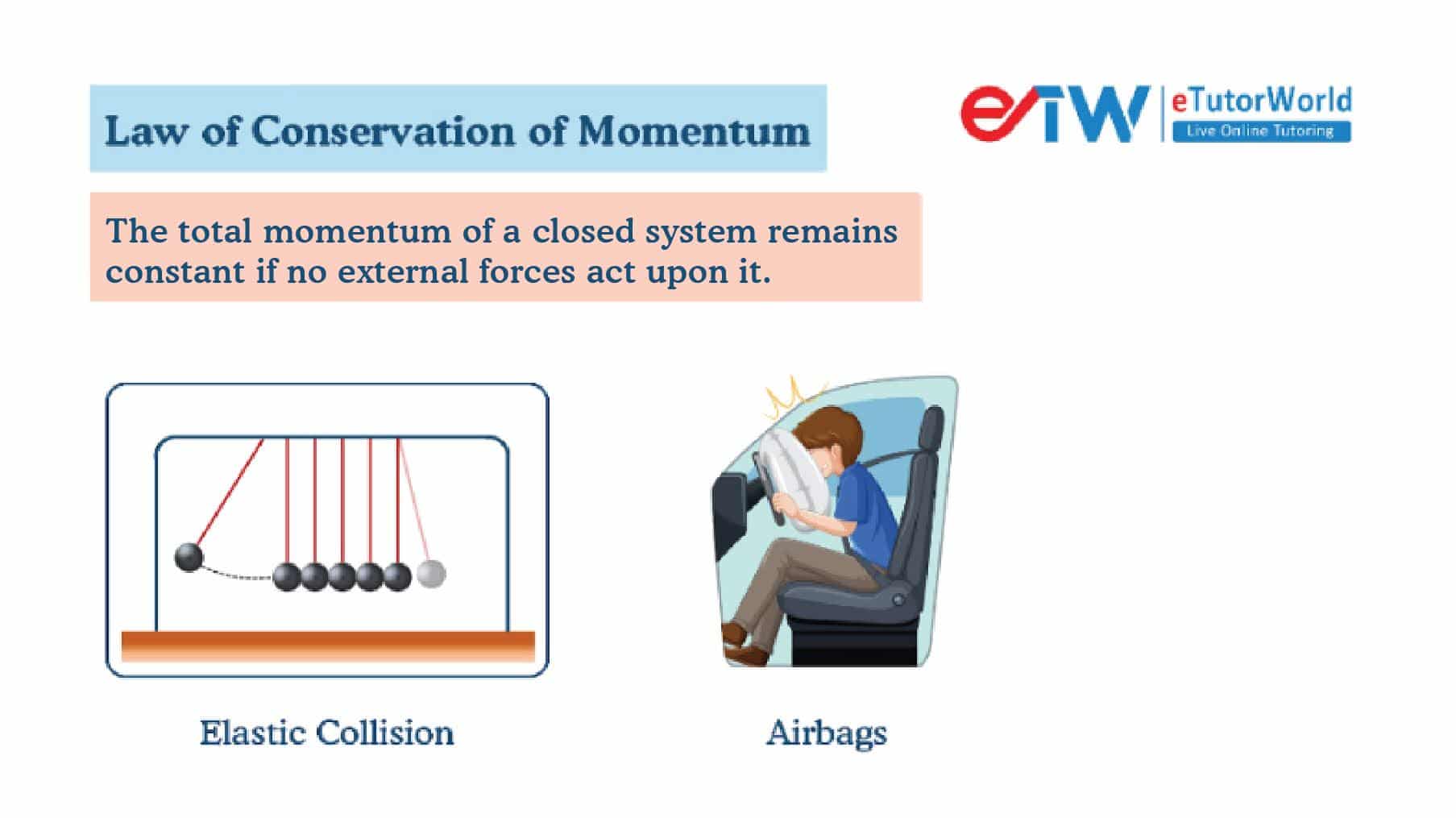Law of Conservation of Momentum
Grade 9 Science Worksheets
The law of conservation of momentum states that the total momentum of a closed system remains constant if no external forces act upon it
Table of Contents:
- Law of Conservation of Momentum
- Derivation
- Examples of Law of Conservation of Momentum
- FAQs
Law of Conservation of Momentum - Grade 9 Science Worksheet PDF
This is a free printable / downloadable PDF worksheet with practice problems and answers. You can also work on it online.
|
Untimed | |
Sign up with your email ID to access this free worksheet.
"We really love eTutorWorld!"
"We really love etutorworld!. Anand S and Pooja are excellent teachers and are quick to respond with requests to tutor on any math topic!" - Kieran Y (via TrustSpot.io)
"My daughter gets distracted easily"
"My daughter gets distracted very easily and Ms. Medini and other teachers were patient with her and redirected her back to the courses.
With the help of Etutorworld, my daughter has been now selected in the Gifted and Talented Program for the school district"
- Nivea Sharma (via TrustSpot.io)
Law of Conservation of Momentum
The total momentum of all objects in the system before an interaction is equal to the total momentum of all objects in the system after the interaction, provided that there are no external forces acting on the system.
Mathematically, this can be expressed as:
Σp_i = Σp_f
where Σp_i represents the initial total momentum of the system and Σp_f represents the final total momentum of the system.

This law is an important concept in physics, as it helps us understand the behavior of objects in motion, such as collisions or explosions. By using the law of conservation of momentum, we can make predictions about the motion of objects before and after an interaction, without needing to know the exact details of the interaction itself.
Derivation
The law of conservation of momentum can be derived from Newton’s laws of motion. Specifically, it is based on Newton’s third law, which states that for every action, there is an equal and opposite reaction.
Consider a system of two objects, A and B, with masses m1 and m2, respectively. Let v1i and v2i be their initial velocities before they interact. Suppose the objects collide with each other, and as a result, their velocities change to v1f and v2f, respectively.
According to Newton’s second law, the force acting on an object is equal to its mass times its acceleration. In this case, the forces acting on objects A and B during the collision are equal in magnitude and opposite in direction, as dictated by Newton’s third law. Therefore:
F_A = -F_B
where F_A and F_B are the forces acting on objects A and B, respectively.
By Newton’s second law, we have:
F_A = m1 * (v1f – v1i) / t
F_B = m2 * (v2f – v2i) / t
where t is the time for which the force acts.
If we multiply each equation by t and rearrange, we get:
m1 * (v1f – v1i) = -m2 * (v2f – v2i)
Dividing both sides by the time t, we obtain:
m1 * (v1f – v1i) / t = -m2 * (v2f – v2i) / t
Recall that the change in momentum of an object is given by:
Δp = m * (v_f – v_i)
where Δp is the change in momentum, m is the mass of the object, v_f is the final velocity, and v_i is the initial velocity.
Substituting this expression into our previous equation, we obtain:
Δp1 = -Δp2
This equation shows that the change in momentum of object A is equal in magnitude but opposite in direction to the change in momentum of object B. In other words, the total momentum of the system is conserved. This is the law of conservation of momentum.
Note that this derivation assumes that there are no external forces acting on the system during the collision. If there are external forces, then the momentum of the system may not be conserved.
“There have been times when we booked them last minute, but the teachers have been extremely well-prepared and the help desk at etutorworld is very prompt.
Our kid is doing much better with a higher score.”
9th Grade Tutoring
eTutorWorld offers Personalized Online Tutoring for Math, Science, English, and Standardised Tests.
Our Tutoring Packs start at just under $21 per hour, and come with a moneyback guarantee.
Schedule a FREE Trial Session, and experience quality tutoring for yourself. (No credit card required.)
Examples of Law of Conservation of Momentum
The law of conservation of momentum has many real-world applications. Here are some examples:
Elastic collisions: When two billiard balls collide on a pool table, their total momentum is conserved. This is because there are no external forces acting on the system, and the collision is elastic, meaning that the kinetic energy is also conserved.
Rockets: The law of conservation of momentum is used in rocket propulsion. As fuel is expelled out of the rocket’s engines, it generates a force that propels the rocket forward. This force is equal and opposite to the force acting on the fuel, and by Newton’s third law, it results in a change in the rocket’s momentum.
Airbags: The law of conservation of momentum is also used in the design of car airbags. When a car collides with an object, the passengers’ momentum changes rapidly. The airbag inflates and absorbs some of the force of the impact, which reduces the passengers’ momentum and helps to prevent injury.
Planetary motion: The law of conservation of momentum explains the orbits of planets around the sun. The gravitational force between the planets and the sun results in a change in momentum, but the total momentum of the system is conserved.
Atomic physics: The law of conservation of momentum is important in the study of atomic and subatomic particles. When particles collide, their momentum changes in accordance with the law of conservation of momentum. This helps scientists to understand the behavior of these particles and how they interact with each other.

Do You Stack Up Against the Best?
If you have 30 minutes, try our free diagnostics test and assess your skills.
Law of Conservation of Momentum FAQS
What is the law of conservation of momentum?
The law of conservation of momentum states that the total momentum of a closed system remains constant if there are no external forces acting on it.
What is momentum?
Momentum is a measure of an object’s motion. It is equal to the product of an object’s mass and velocity.
What is a closed system?
A closed system is one in which no mass or energy can enter or leave the system. In other words, the system is isolated from its surroundings.
What are external forces?
External forces are forces that act on a system from outside the system. Examples include friction, air resistance, and gravity.
Is the law of conservation of momentum always true?
The law of conservation of momentum is true in all cases where there are no external forces acting on the system. However, in real-world situations, external forces are often present, so the law may not be strictly true.
What is an elastic collision?
An elastic collision is a collision in which the total kinetic energy of the system is conserved. In an elastic collision, the objects bounce off each other without any deformation.
What is an inelastic collision?
An inelastic collision is a collision in which the total kinetic energy of the system is not conserved. In an inelastic collision, the objects stick together or deform upon collision.
What are some real-world examples of the law of conservation of momentum?
Examples include rocket propulsion, car airbags, billiard balls, planetary motion, and atomic physics.
Does the law of conservation of momentum apply to rotating objects?
Yes, the law of conservation of angular momentum applies to rotating objects in the same way that the law of conservation of momentum applies to linear motion.
How is the law of conservation of momentum used in engineering and technology?
The law of conservation of momentum is used in designing rocket engines, airbags, and other safety systems in cars and airplanes. It is also used in studying the behavior of subatomic particles and in understanding the motion of celestial bodies.

Kathleen Currence is one of the founders of eTutorWorld. Previously a middle school principal in Kansas City School District, she has an MA in Education from the University of Dayton, Ohio. She is a prolific writer, and likes to explain Science topics in student-friendly language. LinkedIn Profile
Affordable Tutoring Now Starts at Just $22.49
eTutorWorld offers affordable one-on-one live tutoring over the web for Grades K-12. We are also a leading provider of Test Prep help for Standardized Tests (SCAT, CogAT, MAP, SSAT, SAT, ACT, ISEE, and AP).
What makes eTutorWorld stand apart are: flexibility in lesson scheduling, quality of hand-picked tutors, assignment of tutors based on academic counseling and diagnostic tests of each student, and our 100% money-back guarantee.
Whether you have never tried personalized online tutoring before or are looking for better tutors and flexibility at an affordable price point, schedule a FREE TRIAL Session with us today.
*There is no purchase obligation or credit card requirement
IN THE NEWS

Our mission is to provide high quality online tutoring services, using state of the art Internet technology, to school students worldwide.
Online test prep and practice
SCAT
SSAT
ISEE
PSAT
SAT
ACT
AP Exam
Science Tutoring
Physics Tutoring
Chemistry Tutoring
Biology Tutoring
Math Tutoring
Pre-Algebra Tutoring
Algebra Tutoring
Pre Calculus Tutoring
Calculus Tutoring
Geometry Tutoring
Trigonometry Tutoring
Statistics Tutoring
Quick links
Free Worksheets
Fact sheet
Sales Partner Opportunities
Parents
Passive Fundraising
Virtual Fundraising
Our Expert Tutors
Safe and Secure Tutoring
Interactive Online Tutoring
After School Tutoring
Elementary School Tutoring
Middle School Tutoring
High School Tutoring
Home Work Help
Math Tutors New York City
Press
©2022 eTutorWorld Terms of use Privacy Policy Site by Little Red Bird
©2022 eTutorWorld
Terms of use
Privacy Policy
Site by Little Red Bird










